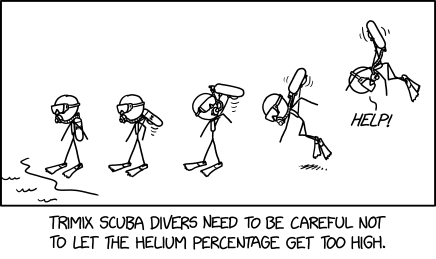Trimix

You don't want the nitrogen percentage to be too high or you run the risk of eutrophication.

You don't want the nitrogen percentage to be too high or you run the risk of eutrophication.
Trimix is a gas used in scuba tanks that consists of oxygen, helium, and nitrogen. Trimix comes in some standard ratios between the component gases, depending on the required diving depth, for example 21/35/44 (percentage oxygen/helium/nitrogen), 18/45/37 and 15/55/30 for increasing depth. Helium safely substitutes a portion of the nitrogen to minimize nitrogen's narcotic effects at greater depths, and to ease the effort required for breathing, as merely reducing the nitrogen ratio in an oxygen/nitrogen mix will increase oxygen to levels that, at the pressures that exist at depth, creates other dangers (hence why the Trimix ratios also provide slightly lower proportions of oxygen). This comic suggests that, if the ratio of helium to nitrogen/oxygen is too high, a diver will float away before reaching the water to start a dive, as their tank of air starts behaving just like a sufficiently buoyant helium balloon. Divers rarely mix their own blends, so this would be the fault of the supplier who filled the tank from which the cylinder is filled. It would also be impossible to disproportionately breathe more of the non-helium, changing the ratio, although the way the comic depicts the tank only just starting to float might suggest that it is somehow being adjusted to the 'wrong' ratio as we watch.
The reason a helium balloon creates lift is that it can inflate. The balloon has a thin and expandable layer, weighing almost nothing, that allows the intrinsically less dense gas to take up space at not much more than atmospheric pressure. The total weight of the filled balloon is less than the total weight of the air it displaces, thus creating buoyancy. A scuba tank is made of metal, is heavy and cannot inflate in anything like normal circumstances.[citation needed] Even with a perfect vacuum inside it (if that were possible) it would still weigh more than the equivalent volume of air. You would simply increase that weight if you pumped helium, or any kind of gas, into it. An inflating helium balloon also gets heavier, but this is more than compensated for by the greater increase in volume. The more you pumped into a rigid metal tank, the denser and heavier it would get, and it will never be able to create any degree of additional lift. The comic falsely implies that adding more helium to the system decreases its net relative weight, without taking into account the need to displace a greater volume of air.
The real reason scuba divers need to be careful with the amount of helium is to not get too little (or too much) oxygen for the intended depth and pressure, as well as reducing the troublesome nitrogen.
The title text asserts that a trimix diver whose gas mix contains an excess of nitrogen runs "the risk of eutrophication". The term eutrophication describes the process by which nutrients ("fertilizers") accumulate in an environment, typically a body of water, leading to consequences that are often unfortunate for inhabitants or users of that environment. The human body is an ecosystem, but one that is not typically subject to eutrophication, due to its manner of acquiring and jettisoning nutrients. Moreover, the nitrogen in trimix is diatomic elemental nitrogen, not the "fixed" nitrogen that serves as a component of eutrophication. The diver would not breathe "fixed" nitrogen unless nitrogen-fixing bacteria were somehow incorporated into the scuba gear, a complex feature of dubious utility. Eutrophication could also be understood as the diver dying of nitrogen exposure thus adding nutrients (the dead body) to the body of water.
Randall addressed the question "how much helium is needed to lift a human body" in a what if? article, Falling With Helium. Helium has also featured in comics 2766: Helium Reserve and 2972: Helium Synthesis.